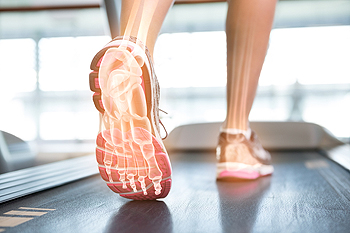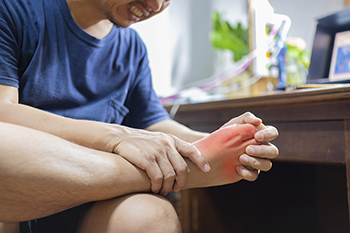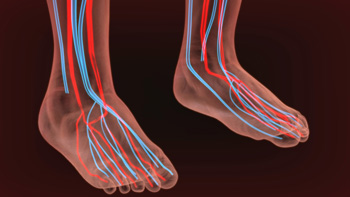Blog
What Are Heel Spurs and How Do They Form?
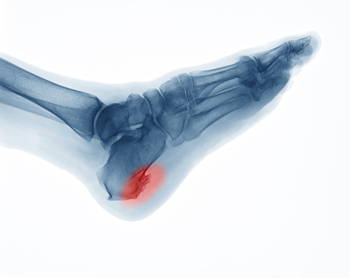
Heel spurs, also referred to as calcaneal spurs or osteophytes, are calcium deposits that develop on the heel bone over time. They typically form in response to chronic strain or tears to the plantar fascia tissue that connects the heel with the toes, or to damage to the heel bone membrane. Other factors that may contribute to heel spurs developing include obesity, wearing improper shoes, age, trauma, training on hard surfaces, or having plantar fasciitis (damage to the plantar fascia) or certain medical conditions. Heel spurs develop on the part of the heel that is closest to the arch, and they point towards the middle of the foot. Heel spurs can be up to a half inch long and are usually only detectable with an X-ray. Heel spurs are usually not painful. When they are, a podiatrist can treat them with rest, ice, orthotic devices and/or shoes, anti-inflammatory medication, cortisone injections, or even surgery if necessary (to remove the spurs).
Heel spurs can be incredibly painful and sometimes may make you unable to participate in physical activities. To get medical care for your heel spurs, contact one of our podiatrists from James Kutchback, DPM, CWS-P. Our doctors will do everything possible to treat your condition.
Heels Spurs
Heel spurs are formed by calcium deposits on the back of the foot where the heel is. This can also be caused by small fragments of bone breaking off one section of the foot, attaching onto the back of the foot. Heel spurs can also be bone growth on the back of the foot and may grow in the direction of the arch of the foot.
Older individuals usually suffer from heel spurs and pain sometimes intensifies with age. One of the main condition's spurs are related to is plantar fasciitis.
Pain
The pain associated with spurs is often because of weight placed on the feet. When someone is walking, their entire weight is concentrated on the feet. Bone spurs then have the tendency to affect other bones and tissues around the foot. As the pain continues, the feet will become tender and sensitive over time.
Treatments
There are many ways to treat heel spurs. If one is suffering from heel spurs in conjunction with pain, there are several methods for healing. Medication, surgery, and herbal care are some options.
If you have any questions, please feel free to contact our offices located in The Woodlands and Woodville, TX . We offer the newest diagnostic and treatment technologies for all your foot care needs.
When to Use Heat or Ice to Reduce Pain

It is common for many people to reach for either an ice pack or a heating pad when they experience minor toe, foot or ankle pain. Heat and ice do frequently work to relieve discomfort, but knowing which one to use can be confusing. The first thing to know is that heat causes blood vessels to open (dilate), and ice causes them to constrict. Heat brings more blood to the injured area, helping to ease pain, spasm and stiffness. It is usually recommended for aching muscles, cramps or stiffness. A heat compress should not be overly hot, or it can burn the skin. A cloth or towel between the compress and the skin is suggested. On the other hand, it is not a good idea to use heat on a new injury, because it can add to any bleeding under the skin. Ice is more often used immediately after an injury to reduce pain, swelling and bruising, and to help numb the area. It is wise to place a cloth or towel between the ice pack and the skin and to leave the ice pack on for no longer than 30 minutes. After a severe ankle injury, especially if you think you may have torn a ligament or broken a bone, it is suggested that you visit a podiatrist immediately for examination, diagnosis and treatment.
Wound care is an important part in dealing with diabetes. If you have diabetes and a foot wound or would like more information about wound care for diabetics, consult with one of our podiatrists from James Kutchback, DPM, CWS-P. Our doctors will assess your condition and provide you with quality foot and ankle treatment.
What Is Wound Care?
Wound care is the practice of taking proper care of a wound. This can range from the smallest to the largest of wounds. While everyone can benefit from proper wound care, it is much more important for diabetics. Diabetics often suffer from poor blood circulation which causes wounds to heal much slower than they would in a non-diabetic.
What Is the Importance of Wound Care?
While it may not seem apparent with small ulcers on the foot, for diabetics, any size ulcer can become infected. Diabetics often also suffer from neuropathy, or nerve loss. This means they might not even feel when they have an ulcer on their foot. If the wound becomes severely infected, amputation may be necessary. Therefore, it is of the upmost importance to properly care for any and all foot wounds.
How to Care for Wounds
The best way to care for foot wounds is to prevent them. For diabetics, this means daily inspections of the feet for any signs of abnormalities or ulcers. It is also recommended to see a podiatrist several times a year for a foot inspection. If you do have an ulcer, run the wound under water to clear dirt from the wound; then apply antibiotic ointment to the wound and cover with a bandage. Bandages should be changed daily and keeping pressure off the wound is smart. It is advised to see a podiatrist, who can keep an eye on it.
If you have any questions please contact our offices located in The Woodlands and Woodville, TX . We offer the newest diagnostic and treatment technologies for all your foot and ankle needs.
Systemic Sclerosis and Foot Health
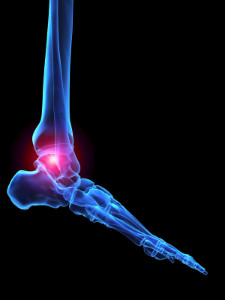
Systemic sclerosis (scleroderma), is an autoimmune rheumatic disease that causes contraction, hardening, and scar formation in the skin, tissues, joints, and even organs. Often the first areas of the body to be affected are the feet, hands, and face. When systemic sclerosis affects the feet, it can cause pain, limited mobility, an abnormal gait, deformity in the back of the foot, calcinosis under the skin’s surface, nail changes, as well as a degradation of skin in the foot. A podiatrist is an important part of the medical team that people with systemic sclerosis should consult with regularly to help them manage symptoms and prevent dangerous complications from developing—such as the development of foot wounds and ulcers. If you have been diagnosed with systemic sclerosis, make an appointment with a podiatrist to make sure you are receiving the regular foot assessment and podiatric care you need.
When dealing with systemic disease of the feet, it is extremely important to check the affected areas routinely so that any additional problems are caught quickly. If you have any concerns about your feet and ankles contact one of our podiatrists from James Kutchback, DPM, CWS-P. Our doctors will assist you with all of your podiatric needs.
Systemic Diseases of the Feet
Systemic diseases affect the whole body, and symptoms usually are displayed in the feet. This condition can make a patient’s ability to walk unbearable. Systemic diseases include gout, diabetes mellitus, neurological disorders, and arthritis.
Gout – is caused by an excess of uric acid in the body. Common symptoms include pain, inflammation, and redness at the metatarsal/phalangeal joint of the base big toe. Gout can be treated by NSAIDs to relieve pain and inflammation, and other drugs that lower the acid levels in the body.
Diabetes mellitus – is an increase in the level of blood sugar that the body cannot counteract with its own insulin. Failure to produce enough insulin is a factor in Diabetes.
Diabetes of the Feet
Diabetic Neuropathy – may lead to damaged nerves and affect the feet through numbness and loss of sensation.
Peripheral Vascular Disease – can restrict the blood flow to the feet, and often times lead to amputation of the feet.
If you have any questions please contact our offices located in The Woodlands and Woodville, TX . We offer the newest diagnostic and treatment technologies for all your foot and ankle needs.
How Can Glucose Levels Be Managed?
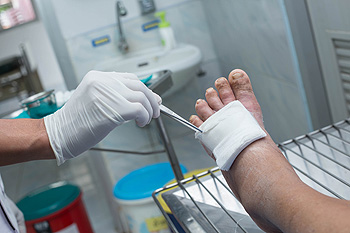 People who have diabetes should understand the importance of inspecting their feet every single day. This is an effective method to check for any cuts, bruises, or wounds that may have developed. Patients who have this condition can have neuropathy, which is a loss of feeling in the feet, and checking the bottom of the feet with a mirror is important to do too. Diabetes occurs as a result of elevated glucose levels in the blood. It is imperative that tests are performed daily which can check sugar levels. Additionally, it can help when cholesterol levels are monitored, and smoking is stopped. It may help to control glucose levels by eating foods that are healthy and becoming physically active. Many diabetic patients find it helpful to have their podiatrist trim their toenails and check their feet. If you have diabetes, it is strongly advised that you are under the care of a podiatrist who can help you to manage this condition.
People who have diabetes should understand the importance of inspecting their feet every single day. This is an effective method to check for any cuts, bruises, or wounds that may have developed. Patients who have this condition can have neuropathy, which is a loss of feeling in the feet, and checking the bottom of the feet with a mirror is important to do too. Diabetes occurs as a result of elevated glucose levels in the blood. It is imperative that tests are performed daily which can check sugar levels. Additionally, it can help when cholesterol levels are monitored, and smoking is stopped. It may help to control glucose levels by eating foods that are healthy and becoming physically active. Many diabetic patients find it helpful to have their podiatrist trim their toenails and check their feet. If you have diabetes, it is strongly advised that you are under the care of a podiatrist who can help you to manage this condition.
Diabetic foot care is important in preventing foot ailments such as ulcers. If you are suffering from diabetes or have any other concerns about your feet, contact one of our podiatrists from James Kutchback, DPM, CWS-P. Our doctors can provide the care you need to keep you pain-free and on your feet.
Diabetic Foot Care
Diabetes affects millions of people every year. The condition can damage blood vessels in many parts of the body, especially the feet. Because of this, taking care of your feet is essential if you have diabetes, and having a podiatrist help monitor your foot health is highly recommended.
The Importance of Caring for Your Feet
- Routinely inspect your feet for bruises or sores.
- Wear socks that fit your feet comfortably.
- Wear comfortable shoes that provide adequate support.
Patients with diabetes should have their doctor monitor their blood levels, as blood sugar levels play such a huge role in diabetic care. Monitoring these levels on a regular basis is highly advised.
It is always best to inform your healthcare professional of any concerns you may have regarding your feet, especially for diabetic patients. Early treatment and routine foot examinations are keys to maintaining proper health, especially because severe complications can arise if proper treatment is not applied.
If you have any questions, please feel free to contact our offices located in The Woodlands and Woodville, TX . We offer the newest diagnostic and treatment technologies for all your foot care needs.
Types of Stress Fractures in the Foot and Ankle
Stress fractures are tiny hairline cracks in the bone, usually the result of overuse common in runners, athletes, and people who spend a great deal of time on their feet. Four main types of stress fractures are navicular, calcaneal, metatarsal and Jones. Each targets a different area of the foot and is brought on by different activities. The navicular stress fracture is often caused by sprinting or jumping. The pain occurs on the top inside arch area of the foot. A calcaneal stress fracture occurs in the heel bone (calcaneus), often found in runners, soldiers, or anyone who marches long distances. A metatarsal stress fracture occurs in one of the long bones in the foot (metatarsals) that connect the toes with the heels. It is usually brought on by overuse or poor biomechanics of the foot and is common in runners, dancers and gymnasts. A Jones stress fracture is specific to the 5th metatarsal, the outermost on the foot. It can be caused by turning over on the side of the foot and affects the end of the bone closest to the ankle. Any of these fractures can be painful and take time to heal. If you think you may have developed a stress fracture, it is a good idea to see a podiatrist as soon as possible for a full diagnosis and options for treatment.
Activities where too much pressure is put on the feet can cause stress fractures. To learn more, contact one of our podiatrists from James Kutchback, DPM, CWS-P. Our doctors can provide the care you need to keep your pain free and on your feet.
Dealing with Stress Fractures of the Foot and Ankle
Stress fractures occur in the foot and ankle when muscles in these areas weaken from too much or too little use. The feet and ankles then lose support when walking or running from the impact of the ground. Since there is no protection, the bones receive the full impact of each step. Stress on the feet can cause cracks to form in the bones, thus creating stress fractures.
What Are Stress Fractures?
Stress fractures occur frequently in individuals whose daily activities cause great impact on the feet and ankles. Stress factors are most common among:
- Runners
- People affected with Osteoporosis
- Tennis or basketball players
- Gymnasts
- High impact workouts
Symptoms
Pain from the fractures occur in the area of the fractures and can be constant or intermittent. It will often cause sharp or dull pain with swelling and tenderness. Engaging in any kind of activity which involves high impact will aggravate pain.
If you have any questions please contact our offices located in The Woodlands and Woodville, TX . We offer the newest diagnostic and treatment technologies for all your foot and ankle needs.
What Is Gout Caused By?
Crystals that form between the joints in the big toe can lead to a condition that is known as gout. It can travel to other parts of the body, and it generally begins with the big toe. It is caused by excess uric acid in the bloodstream and lodges between the joints. It often causes debilitating pain, discomfort, and difficulty walking. Uric acid build-ups can be caused by eating foods that have high levels of purines. These types of foods include shellfish, red meat, excess alcohol, and drinks that have a high sugar content. Additionally, gout attacks may be caused by genetic factors, and it is helpful to take measures that can control these episodes. Gout can possibly be controlled by maintaining a healthy weight, and incorporating an exercise routine into the daily regime. It is important that you are under the care of a podiatrist who can properly diagnose gout, and offer the best treatment solutions for you.
Gout is a foot condition that requires certain treatment and care. If you are seeking treatment, contact one of our podiatrists from James Kutchback, DPM, CWS-P. Our doctors will treat your foot and ankle needs.
What Is Gout?
Gout is a type of arthritis caused by a buildup of uric acid in the bloodstream. It often develops in the foot, especially the big toe area, although it can manifest in other parts of the body as well. Gout can make walking and standing very painful and is especially common in diabetics and the obese.
People typically get gout because of a poor diet. Genetic predisposition is also a factor. The children of parents who have had gout frequently have a chance of developing it themselves.
Gout can easily be identified by redness and inflammation of the big toe and the surrounding areas of the foot. Other symptoms include extreme fatigue, joint pain, and running high fevers. Sometimes corticosteroid drugs can be prescribed to treat gout, but the best way to combat this disease is to get more exercise and eat a better diet.
If you have any questions, please feel free to contact our offices located in The Woodlands and Woodville, TX . We offer the newest diagnostic and treatment technologies for all your foot care needs.
How Poor Circulation Can Affect the Feet
Do your feet feel cold—even when it is not cold outside— or numb? Have you noticed that your feet look white, red, blue, or purple at times? If so, you may have poor circulation in your feet. This condition develops when the blood vessels that deliver a steady supply of oxygen and nutrients to the feet through blood constrict or harden. Other symptoms of poor circulation include a loss of hair on the feet or legs, foot or ankle wounds that have trouble healing, cracked or dry skin, and weak toenails. Poor circulation in the feet may be caused by various underlying conditions. Raynaud’s disease can cause spasms in blood vessels and a decrease in the amount of blood to the toes. Constricting blood vessels can sometimes be attributed to acrocyanosis, which may turn the toes blue and make your skin feel cold and clammy. Many people with diabetes suffer from poor circulation due to elevated blood sugar levels. This is particularly dangerous, as this condition can make it difficult for the diabetic to detect wounds. High blood pressure can lead to arteriosclerosis, which can cause arteries to harden and restrict blood flow. Peripheral artery disease (PAD) is a buildup of plaque in the arteries, which also restricts blood flow. If you are experiencing any of the symptoms described here, it is suggested that you make an appointment as soon as possible with a podiatrist.
Poor circulation is a serious condition and needs immediate medical attention. If you have any concerns with poor circulation in your feet contact one of our podiatrists of James Kutchback, DPM, CWS-P. Our doctors will treat your foot and ankle needs.
Poor Circulation in the Feet
Poor blood circulation in the feet and legs is can be caused by peripheral artery disease (PAD), which is the result of a buildup of plaque in the arteries.
Plaque buildup or atherosclerosis results from excess calcium and cholesterol in the bloodstream. This can restrict the amount of blood which can flow through the arteries. Poor blood circulation in the feet and legs are sometimes caused by inflammation in the blood vessels, known as vasculitis.
Causes
Lack of oxygen and oxygen from poor blood circulation restricts muscle growth and development. It can also cause:
- Muscle pain, stiffness, or weakness
- Numbness or cramping in the legs
- Skin discoloration
- Slower nail & hair growth
- Erectile dysfunction
Those who have diabetes or smoke are at greatest risk for poor circulation, as are those who are over 50. If you have poor circulation in the feet and legs it may be caused by PAD and is important to make changes to your lifestyle in order to reduce risk of getting a heart attack or stroke. Exercise and maintaining a healthy lifestyle will dramatically improve conditions.
As always, see a podiatrist as he or she will assist in finding a regimen that suits you. A podiatrist can also prescribe you any needed medication.
If you have any questions, please feel free to contact our offices located in The Woodlands and Woodville, TX . We offer the newest diagnostic and treatment technologies for all your foot care needs.
Causes of Metatarsal Pain in the Ball of the Foot
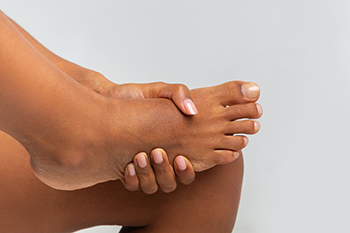 When you feel pain in the ball of the foot it could be a sign of metatarsalgia. This condition can have several causes, some more simple to correct than others. For instance, in some cases just changing your footwear from high-heeled shoes to flatter heels, therefore reducing the pressure on the ball of the foot, can help. Many runners develop metatarsalgia from overuse, caused by running longer distances more often. Sports that involve jumping may also bring about this injury. Being overweight, having a hammertoe or bunion that affects your gait, or having stiffness in the ankle or Achilles tendon, can also cause more stress on the metatarsal bones. The pain generated by metatarsalgia usually starts gradually and gets worse the more you stand, walk, run, or further aggravate the foot. A podiatrist can examine your foot with X-rays or other imaging tests, make a proper diagnosis, and suggest treatment options depending on the underlying cause and the severity of the pain. If you are struggling with pain in the ball of your foot it is suggested that you schedule an appointment with your local podiatrist.
When you feel pain in the ball of the foot it could be a sign of metatarsalgia. This condition can have several causes, some more simple to correct than others. For instance, in some cases just changing your footwear from high-heeled shoes to flatter heels, therefore reducing the pressure on the ball of the foot, can help. Many runners develop metatarsalgia from overuse, caused by running longer distances more often. Sports that involve jumping may also bring about this injury. Being overweight, having a hammertoe or bunion that affects your gait, or having stiffness in the ankle or Achilles tendon, can also cause more stress on the metatarsal bones. The pain generated by metatarsalgia usually starts gradually and gets worse the more you stand, walk, run, or further aggravate the foot. A podiatrist can examine your foot with X-rays or other imaging tests, make a proper diagnosis, and suggest treatment options depending on the underlying cause and the severity of the pain. If you are struggling with pain in the ball of your foot it is suggested that you schedule an appointment with your local podiatrist.
Foot Pain
Foot pain can be extremely painful and debilitating. If you have a foot pain, consult with one of our podiatrists from James Kutchback, DPM, CWS-P. Our doctors will assess your condition and provide you with quality foot and ankle treatment.
Causes
Foot pain is a very broad condition that could be caused by one or more ailments. The most common include:
- Bunions
- Hammertoes
- Plantar Fasciitis
- Bone Spurs
- Corns
- Tarsal Tunnel Syndrome
- Ingrown Toenails
- Arthritis (such as Gout, Rheumatoid, and Osteoarthritis)
- Flat Feet
- Injury (from stress fractures, broken toe, foot, ankle, Achilles tendon ruptures, and sprains)
- And more
Diagnosis
To figure out the cause of foot pain, podiatrists utilize several different methods. This can range from simple visual inspections and sensation tests to X-rays and MRI scans. Prior medical history, family medical history, and any recent physical traumatic events will all be taken into consideration for a proper diagnosis.
Treatment
Treatment depends upon the cause of the foot pain. Whether it is resting, staying off the foot, or having surgery; podiatrists have a number of treatment options available for foot pain.
If you have any questions, please feel free to contact our offices located in The Woodlands and Woodville, TX . We offer the newest diagnostic and treatment technologies for all your foot care needs.





